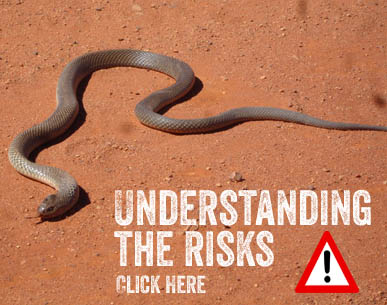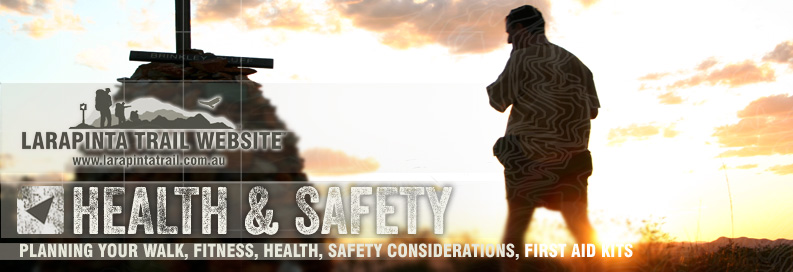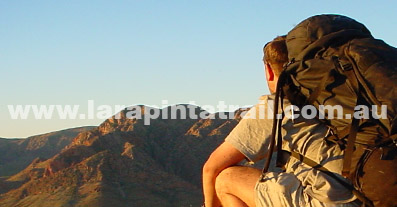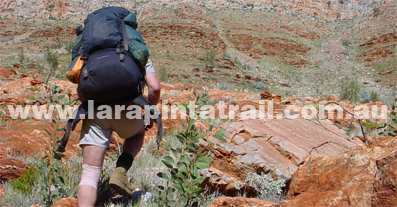 Planning Your Walk Planning Your Walk |
| Your walking experience will be influenced by your level of fitness, experience, prior planning, equipment selection and understanding of the environmental conditions of the Larapinta Trail. Take in to consideration some of the following planning points: |
|
 Health and Fitness Considerations Health and Fitness Considerations |
| Attempting any outdoor activity will require a reasonably good level of individual health and fitness. However walking the Larapinta Trail will require a very good level of fitness particularly cardiovascular and endurance based fitness. If you plan to complete some of the harder sections of this trail, you may consider planning and training for the following common Larapinta Trail conditions: |
 |
Walking over steep, rugged and broken terrain
|
 |
Walking in warm and sunny conditions |
 |
Carrying a 15-20kg pack over rough terrain |
 |
Regular or constant exposure to sun and UV |
 |
Dry winds, low humidity increasing thirst and dehydration |
|
 Seeking Advice and Understanding Your Limitations Seeking Advice and Understanding Your Limitations
|
| All aspects of the body will be used along this trail, namely the legs, ankles, thighs, shoulders, hands, wrists and back. In order to plan for such physical exertion, exposure and impacts to your body, it is recommended that you consider the following: |
 |
Discussing the walk with your GP and seek advice
|
 |
Developing a fitness program before hand |
 |
Seek professional advice from physio’s and personal trainers |
 |
Physiologically preparing yourself for the walk |
 |
Be acutely aware of the trail conditions  and climatic conditions and climatic conditions  |
 |
Recognise your limitations & constraints |
 |
Manage your previous injuries and conditions |
 |
Choose the right equipment  |
 |
If necessary acclimatise to Central Australian climate  before the walk before the walk |
|
 Medical and First Aid Kit Considerations Medical and First Aid Kit Considerations |
| First Aid and medical kits are one of the most basic essential equipment items for hiking. Most experienced hikers customise their first aid and medical kits which includes packing all the basic items (see list), items for personal medical needs as well packing specific items for the conditions of the area or trail they are walking in. The following are some first aid and medical kit items specific and directly relevant to the Larapinta Trail; |
 |
Crepe bandages for muscle/ligament sprains, strains or bone breaks
|
 |
Sunscreen with maximum protection |
 |
Skin moisturiser |
 |
Electrolyte powder |
 |
Water purification tables |
 |
Antiseptic cream/liquid for cuts and infections ( i.e. spinifex pricks) |
 |
Antibacterial hand wash or wipes |
 |
Anti Inflammatory cream or jel |
 |
Anti histamine
|
 |
Insect bite cream with lignocaine |
 |
Multivitamin Tablets |
 |
Moisturisers for dry and cracked skin |
|
|
| Constantly monitor your physical condition while on the trail. Over exertion is one of the greatest risks with hikers on the Larapinta Trail. For example, once dehydration sets in, so does exhaustion and the onset of other heat related illnesses such as heat exhaustion and heat stroke. When in a weakened state, accidents are also more likely to occur. While this may sound like obvious advice, we never ceased to be amazed at how many hikers are caught out this way. |
 |
Take time to rest (preferably in the shade)
|
 |
Rehydrate your body by regularly drinking water |
 |
Have some energy based food whenever possible |
 |
Supplement your water with electrolytes |
 |
If you like hot drinks, try drink tea more than coffee |
 |
Monitor your physical condition at all times |
|
 If You Get Sick or Injured and Need Evacuation If You Get Sick or Injured and Need Evacuation |
| A surprising number of people develop some form of illness or injury while on the Larapinta Trail such as gastro, throat infections, sprained ankles, blistered feet or infected cuts. While most walkers manage their injuries and continue walking, other more serious conditions need external agency evacuation. Some points to consider: |
 |
Carry out immediate first aid to yourself or others |
 |
Make yourself as comfortable as possible |
 |
Know exactly where you are to assist in evacuation |
 |
Prepare all your emergency communication devices  to aid in the evac to aid in the evac |
 |
Advise authorities of your need for evacuation |
 |
Advise authorities the level of seriousness of the injury/illness |
 |
Advise authorities on what the injury or illness is |
|
 If You Get Lost on the Larapinta Trail If You Get Lost on the Larapinta Trail |
| This does happen. There are a number of points along the Larapinta Trail where the track is difficult to identify, particularly on the high ground, steep areas, gorges, creek lines and gullies. Hikers regularly veer off the trail. But some people truly get lost on the Larapinta Trail. Here are some courses of action to consider: |
 |
Stop, rest and stay calm ( preferably in the shade)
|
 |
Don’t panic. Look for soil or ground compaction & footprints |
 |
If it’s dark stay where you are until daylight |
 |
If you are in a group, don’t separate |
 |
Study your map and make an appraisal where you might be |
 |
Use your GPS ( if you have one) |
 |
Don’t back track unless you are absolutely sure where to backtrack to |
 |
If you are absolutely totally lost, signal for help ( for nearby hikers) |
 |
If all fails use your SATPHONE & call for help or initiate your PLB |
 |
Prepare to signal people or aircraft as they near you |
|
 |
|






